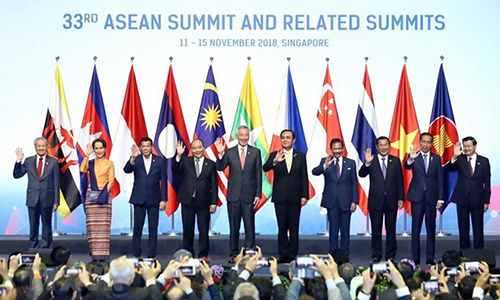ASEAN connectivity enhanced under Singapore's chairmanship
ABO/VNA – Cooperation and connectivity in the Association of Southeast Asian Nations (ASEAN) have seen improvements in 2018 under Singapore’s chairmanship, which was themed “Resilience and Innovation”.
 |
| Vietnamese Prime Minister Nguyen Xuan Phuc (fourth, left) and other ASEAN leaders at the 33rd ASEAN Summit in Singapore last November (Photo: VNA). |
The 33rd ASEAN Summit and related meetings last November concluded Singapore’s chairmanship.
Ensuring ASEAN’s central role and the region’s dynamic development was Singapore’s target for the bloc this year.
It put forth three focuses during its chairmanship, namely maintaining the rule-based regional order to help ASEAN better resolve emerging security challenges like cyber security, trans-national crime and terrorism; promoting regional economic integration and connectivity to enhance prosperity and competitiveness; and finding creative ways in digital technology management and utilisation, and improving people’s ability to adapt to a digital economy.
Under Singapore’s chairmanship, the bloc has maintained its centrality and consolidated ASEAN-led dialogue and cooperation mechanisms, attaining major outcomes in building an ASEAN Community and realising the ASEAN Community Vision 2025, while contributing to peace and stability in the region.
The procession of community building included a series of initiatives proposed by Singapore and other member nations. Notably, leaders adopted the ASEAN Smart Cities Network to connect 26 cities in the region to facilitate access to achievements generated by the community building.
ASEAN also received strong support from its partners and played its role in dealing with emerging issues, especially large natural disasters.
Its relations with partners have been enhanced through special summits with Australia and India.
Aside from those strides, the grouping also faces difficulties and challenges posed by complex changes in the international and regional environment, as well as in ASEAN itself.
The changing geo-political balance has turned ASEAN into a “front” for powerful countries to compete for influence. Additionally, the free, open and rule-based multilateral system that has contributed to ASEAN’s growth and stability is under pressure as some countries, including world powers, do not support multilateralism.
Facing this fact, ASEAN leaders have reiterated the key requirement is maintaining solidarity, unanimity and the central role of ASEAN and solidifying an open, transparent and rule-based regional cooperation architecture with ASEAN at the centre.
Cohesion is considered the “catalyst” assisting the bloc to adapt to the changing international environment and sustain its central role in the region in the face of other blocs or regional cooperation projects. It is also an important factor for ASEAN to be recognised as a valuable partner of powers in the world.
Cohesion will also help strengthen the Southeast Asian region’s capacity to cope with common threats like terrorism, cyber-crime and climate change, and grasp opportunities and respond to unwanted impacts of the digital technology revolution.
With the efforts and steps taken in 2018, ASEAN has shaped new directions to move forward and build a steadfast, resilient and cohesive community.
(Source: VNA)
.
 về đầu trang
về đầu trang







